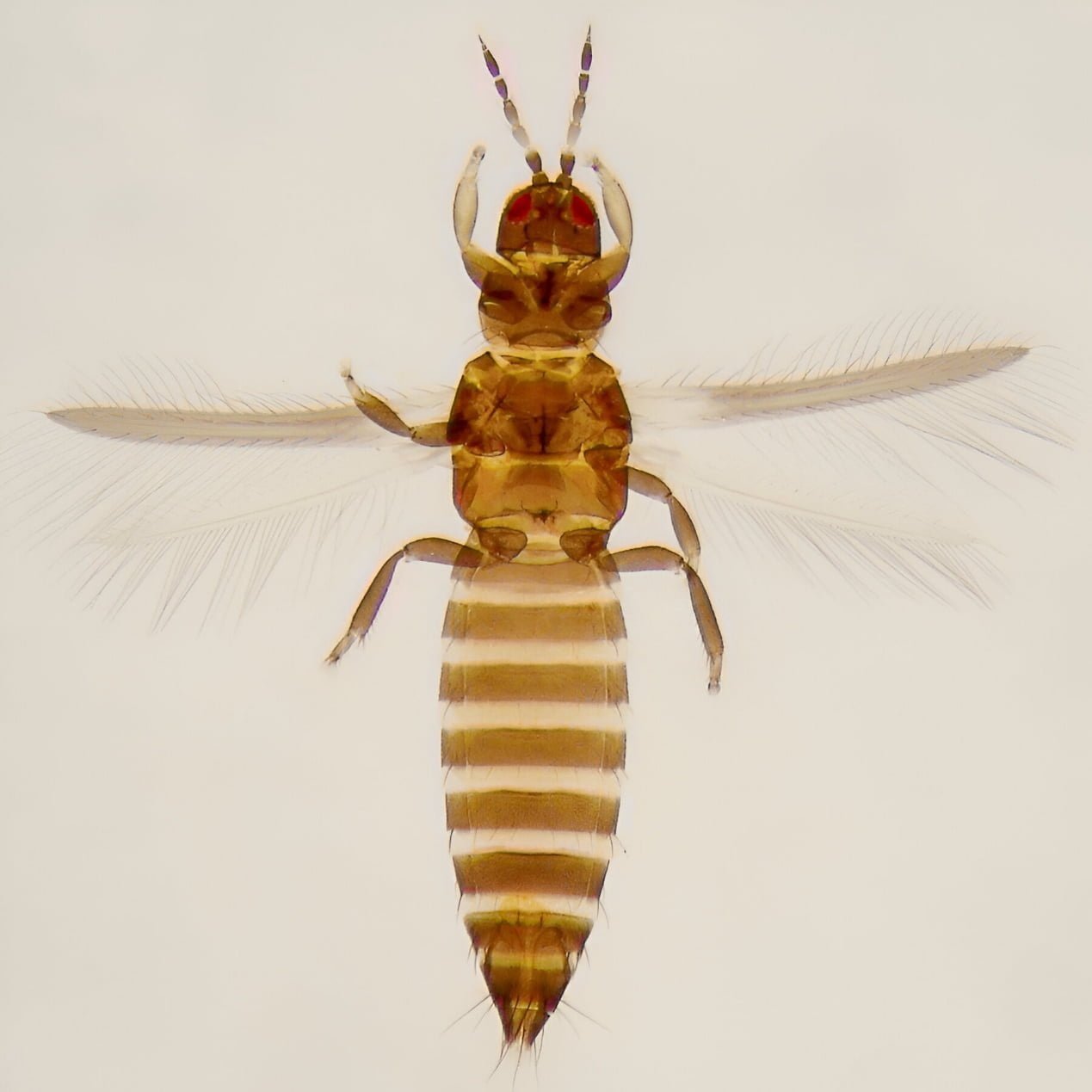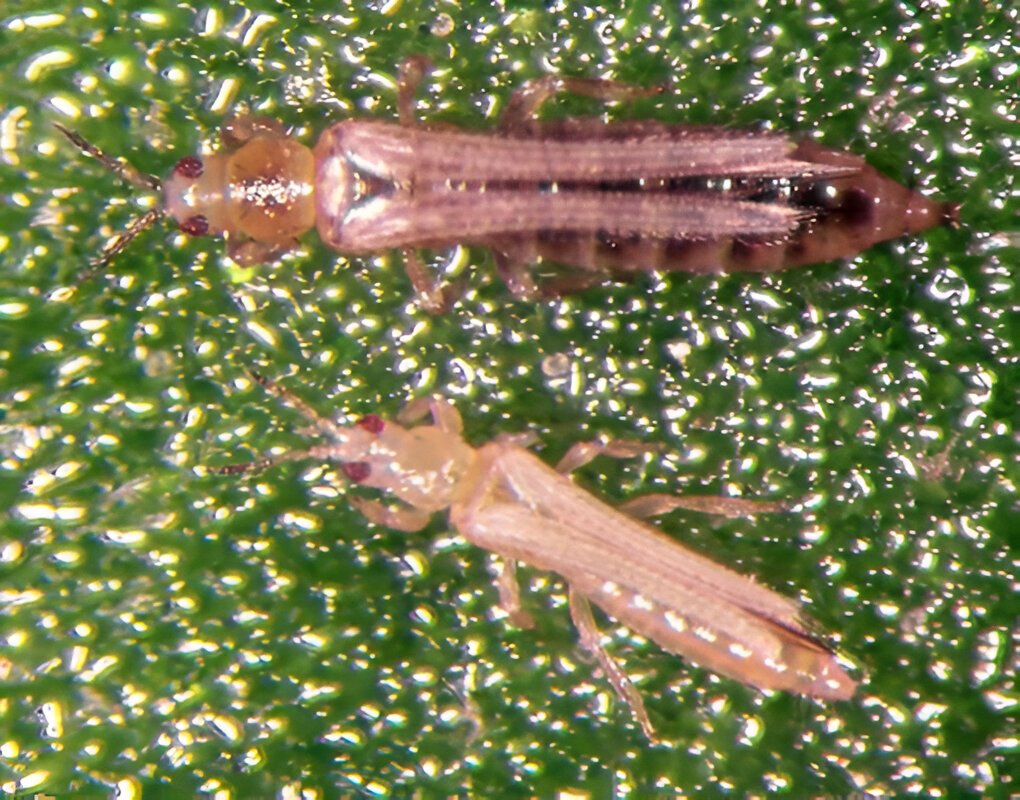Table of contents of the article
ToggleFlower thrips are harmful agricultural pests that affect many crops. In this article on your website, World of Plants, we will discuss prevention and control methods to preserve the crop.
Symptoms of flower thrips
- Scientific name : Frankliniella sp
- the family : Thripidae
- Type of disease: Insect
- Leaves and flowers become distorted and hinder the growth of young plants.
- The upper part of the plant leaves is damaged very quickly, in addition to the deformation of the fruits.
- Black spots appear on plant leaves, which are the pest’s droppings
- White or brown spots appear on flowers or leaves as plant cells are destroyed.
- Infected leaves suffer from curling and bending of the edges.


Description of the flower thrips insect
The insect is pale brown or black with light collars on the abdominal vertebrae and is (1) 1.5 mm long.
Young insect nymphs are less dark and black in color than adults, except for the head, antennae and legs, which are lemon yellow.


Causes of flower thrips
- It is active during the spring as the temperature rises
- It is transmitted by wind and through infected plants
- It is transmitted as a result of the use of agricultural tools
- It spreads very quickly in plastic reserves.
- The farmer does not care about the general condition of the fields and orchards of strawberries, citrus fruits, cherries, peaches, and others.
- Growing crops and small plants between fruit trees is not permissible.
- Neglecting mineral fertilization of fruit trees and small plants weakens their resistance to pests and attracts thrips.
Suitable conditions for the spread of flower thrips
Temperatures above 28°C encourage this thrips in fields and orchards
Floral thrips development cycle
- The female embeds her eggs in the tissues of flower buds or flat leaves
- The wingless nymphs live on wrapped leaves and go through three stages.
- The pest's life cycle takes (2-5) weeks.
- The flower thrips insect is active in spring and summer.
- The pest spends the winter under the leaves, in the cracks of buds ready to open, or in the cracks of the stems, twigs and branches of fruit trees.
- In spring, with high temperatures of 28°C and above, the pest migrates to the lower surface of the leaves.
- After mating, the female begins laying about 50-100 eggs starting in mid-April with her egg-laying machine. Eggs are laid within the tissues of the lower surface of the leaf, or within the buds.
- The first generation insects appear in March, while the second generation insects begin to appear in August, or may be delayed until the beginning of September. As for the third and final generation insects, they appear at the beginning of October, as they migrate to a new place when damaged flowers fall in the fields.
Losses from the spread of flower thrips
- Thrips are considered one of the most harmful pests to crops because they scrape the inner membranes of plant leaves, making them weak and reducing growth opportunities until they reach the stage of damage.
- Insects can transmit viruses, especially those that cause wilt.
- They feed on fruits, causing them to become infected with bacteria.
- Decreased marketing value of the crop as a result of deformed fruits.

Control strategy
Preventive measures to prevent the occurrence of flower thrips
- Continuing to expose the soil to the sun, which helps eliminate insects found inside the soil
- Get rid of weeds in the soil regularly
- Pay attention to abundant irrigation before planting.
- Do not overuse nitrogen fertilizers.
- Dispose of any plant waste in the place and remove infected plants.
- Remove flowers and leaves that have been infected with thrips to help the flowers grow again
Chemical and organic control recommendations against flower thrips
- Organic control
- Plant insect-resistant plants, avoiding planting next to grassy areas.
- Organic or plastic mulch can be used on rows to reduce the spread of thrips.
- Use sticky traps near planted plants.
- Use a damp cloth to eliminate the largest amount of thrips and get rid of their larvae.
- Predators such as lion aphid larvae as well as aphid larvae
- Chemical control:
- Equal amounts of superphosphate and potassium are soaked in water for a full day, filtered and sprayed on the leaves to prevent infection
- We rely on the use of mineral oils such as Oil 95, Actelec 50, and Sumethion 50% EC, which are sprayed alternately to eliminate thrips.
- Treatment is not carried out until the population reaches less than 10 individuals on the plant and flowers. Spraying every two weeks for 3-4 sprays. Stop spraying no less than 21 days before harvesting.
In conclusion, we would like to note that we, at the world of plants website, offer you all the necessary services in the world of plants, we provide all farmers and those interested in plants with three main services::-
- Artificial intelligence consulting service to help you identify diseases that affect plants and how to deal with them.
- Blog about plants, plant diseases and care of various crops ... You are currently browsing one of her articles right now.
- An application that provides agricultural consultations to clients, as well as a service for imaging diseases and knowing their treatment for free – Click to download the Android version from Google Play Store، Click to download the IOS version from the Apple App Store.
References:
- JOHNSEN, Roberto M. The Frankliniella curiosa species group (Thysanoptera: Thripidae). Revista de Biología Tropical, 1998, 46: 717-738.
- Gillespie, D. R., & Quiring, D. M. (1990). BIOLOGICAL CONTROL OF FUNGUS GNATS, BRADYSIA SPP.(DIPTERA: SCIARIDAE), AND WESTERN FLOWER THRIPS, FRANKLINIELLA OCCIDENTALS (PERGANDE)(THYSANOPTERA: THRIPIDAE), IN GREENHOUSES USING A SOIL-DWELLING PREDATORY MITE, GEOLAELAPS SP. NR. ACULEIFER (CANESTRINI)(ACARI: LAELAPIDAE) 1. The Canadian Entomologist, 122(5), 975-983.
- Navas, S. V., Funderburk, J. E., Beshear, R. J., Olson, S. M., & Mack, T. P. (1991). Seasonal patterns of Frankliniella spp. (Thysanoptera: Thripidae) in tomato flowers. Journal of Economic Entomology, 84(6), 1818-1822
- PRZYBYLSKA, Arnika; FIEDLER, Żaneta; OBRĘPALSKA-STĘPLOWSKA, Aleksandra. PCR-RFLP method to distinguish Frankliniella occidentalis, Frankliniella intonsa, Frankliniella pallida and Frankliniella tenuicornis. Journal of Plant Protection Research, 2016
- The Frankliniella curiosa species group (Thysanoptera: Thripidae) – Universidad de Costa Rica
- BIOLOGICAL CONTROL OF FUNGUS GNATS, BRADYSIA SPP. (DIPTERA: SCIARIDAE), AND WESTERN FLOWER THRIPS – cambridge
- Seasonal Patterns of Frankliniella spp. (Thysanoptera: Thripidae) in Tomato Flowers – Journal of Economic Entomology




